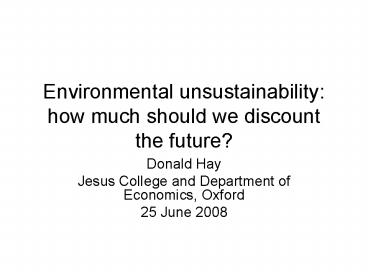Environmental unsustainability: how much should we discount the future
1 / 10
Title:
Environmental unsustainability: how much should we discount the future
Description:
Stern Review: 2.2% for the current century, and 1.4% long term ... Taking the side of Stern against Nordhaus: reasons for supporting low discount rates ... – PowerPoint PPT presentation
Number of Views:44
Avg rating:3.0/5.0
Title: Environmental unsustainability: how much should we discount the future
1
Environmental unsustainability how much should
we discount the future?
- Donald Hay
- Jesus College and Department of Economics, Oxford
- 25 June 2008
2
Environmental unsustainability
- Two key processes
- Biological resources fish, forests, animals
over time harvested to destruction/ extinction - External effects in production pollution, CO2
emissions over time generate cumulative costs
to others, even globally.
3
Discounting the future what does it mean?
- Investing 100 at 5 gives 105 in a years time
- A receipt or cost of 100 in a years time is
worth 95.25 now, if the interest rate is 5.
Present values. - Over many years, the discounting is compounded.
4
Discounting interest rates and present values of
1
5
Implications of discounting
- Consumers attitudes to future consumption
firms attitudes to investment. Myopic behaviour?
- Biological resources if regeneration is less
than the discount rate, then no point in
conserving stock to next period. - Climate change identified cost of 1million in
50 years time present value at 0.5 is 780k,
but only 230k at 3.0 so investment of 250k to
prevent cost only worth it if interest rate is a
bit less than 3.0 - Cost of carbon build up of greenhouse gases over
the long term current cost much higher if
discount rate is low, so carbon tax should be
higher.
6
What value for the discount rate?
- Economists disagree whats new about that!
- Stern Review 2.2 for the current century, and
1.4 long term - Nordhaus 6 is more appropriate
- Why the disagreement?
7
How much should we discount the future?
- The role of savings and investment in making
provision for future generations - The pure rate of time discount (a)
impatience (b) non zero risk of destruction of
the earth hazard rate - Future generations getting wealthier so
discount rate depends on (a) growth in incomes
and (b) the weight to be given to higher incomes
accruing to our descendants
8
Why not use market rates?
- Reflects the actual preferences of current
consumers. But future generations lack a voice in
current capital markets, and their interests need
to be protected - Avoids crowding out investment in projects other
than climate change. - What is the market rate?
9
Alternative approaches
- Insuring the future investment to avoid extreme
outcomes. - Choosing what not to discount commodities OK,
but not the environment - Preserving human rights in the future including
rights not to suffer dangerous climate change. Is
the appropriate discount rate for rights zero?
10
The contribution of Christian moral reasoning
- Theocentric versus anthropocentric approaches to
environmental issues - Taking the side of Stern against Nordhaus
reasons for supporting low discount rates - Collective insurance is compatible with
stewardship role for humanity - Caring about the rights of future generations
- Fallen human nature and the need for policy
interventions































